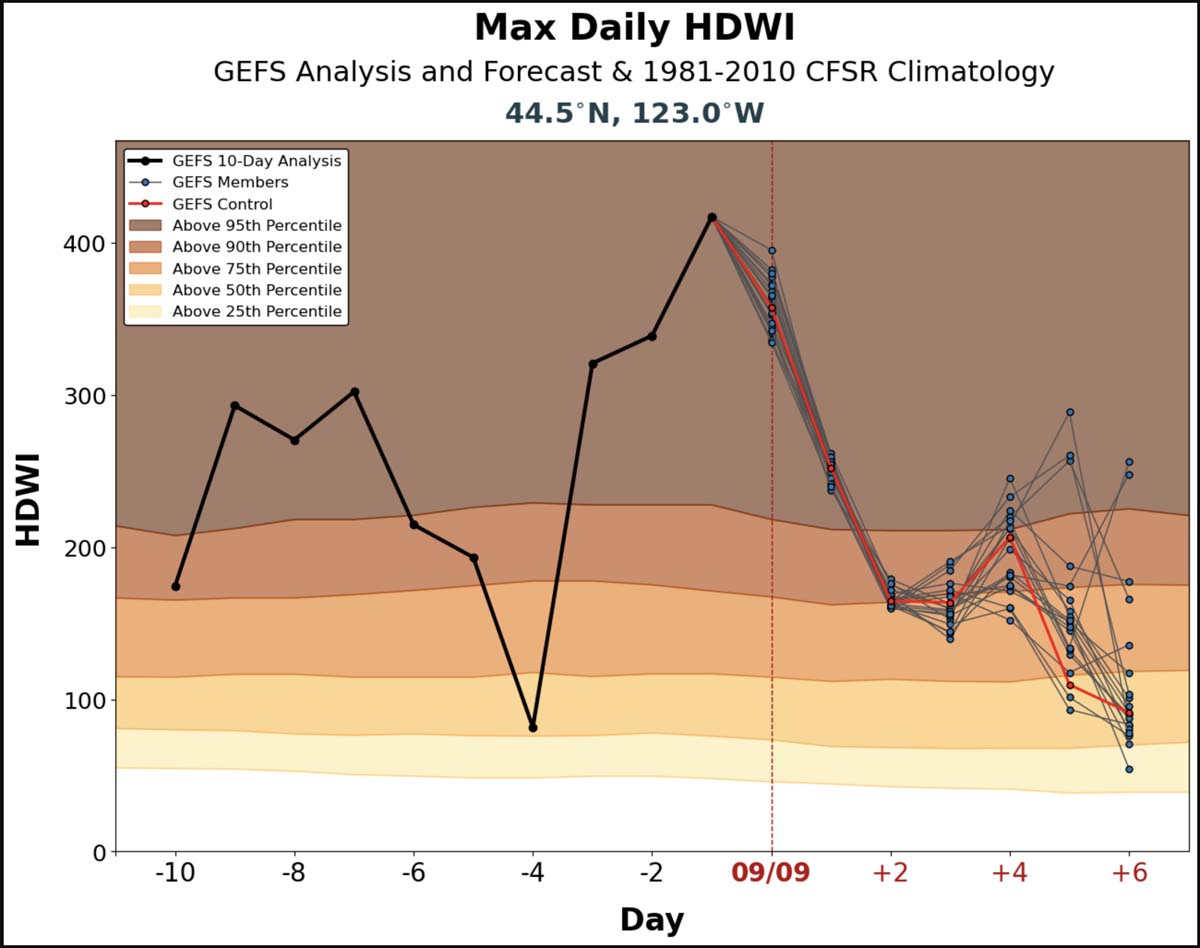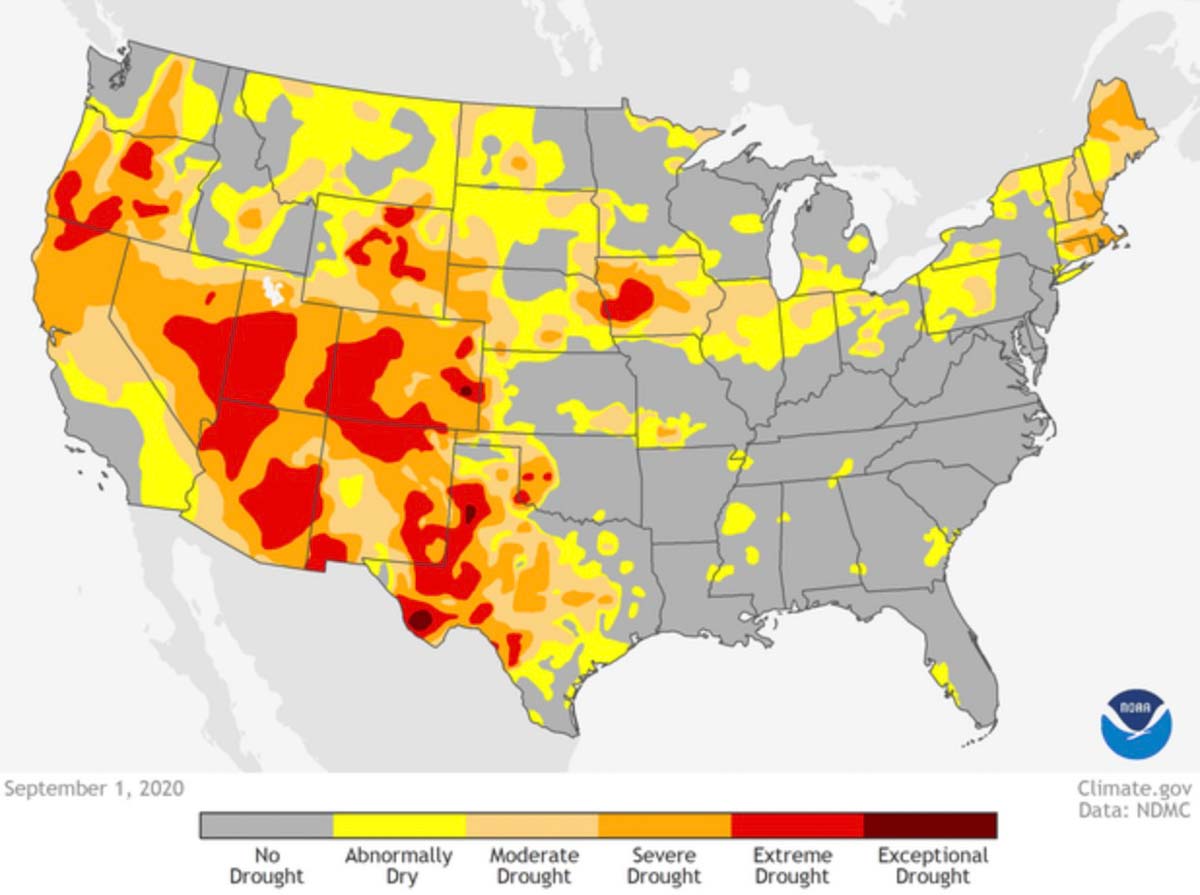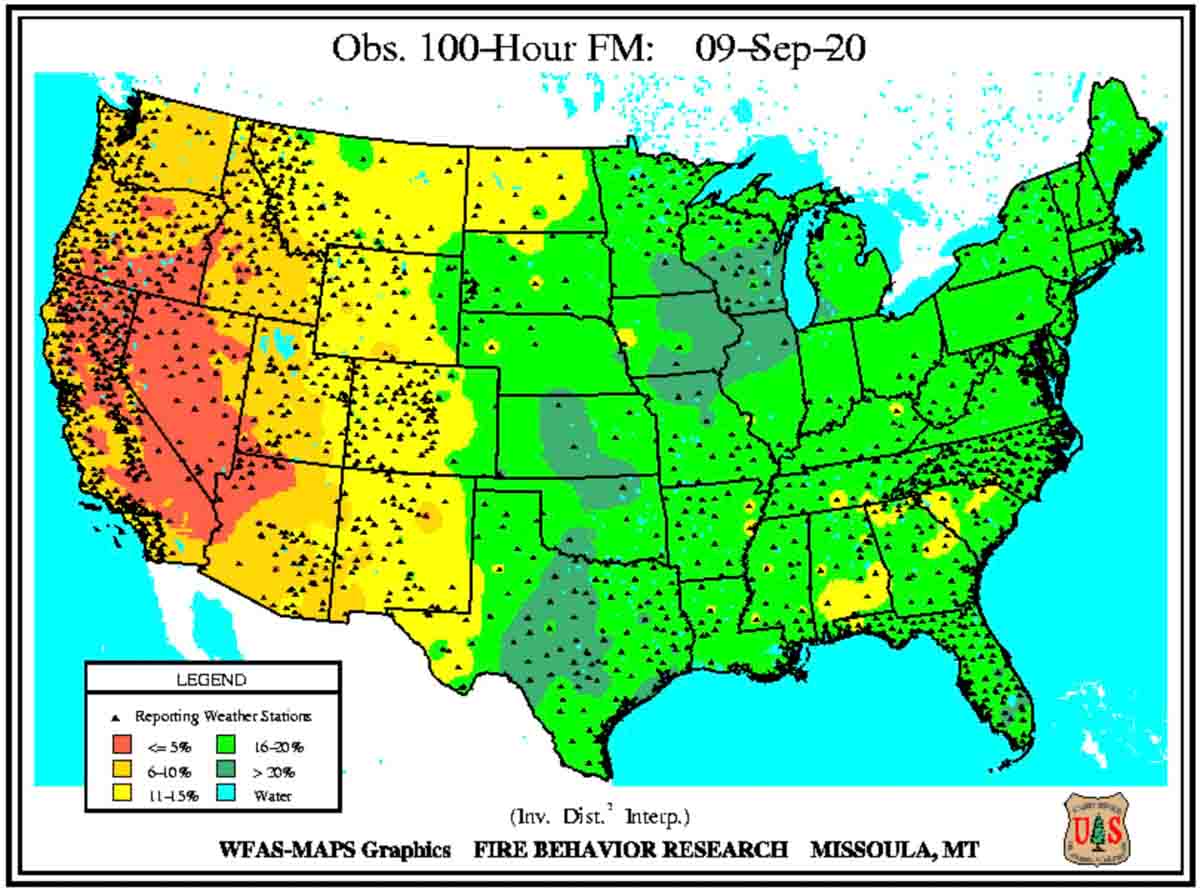September 10, 2020 | 9:42 p.m. PDT

People may wonder why all of a sudden there were numerous very large fires in Oregon this week during what I am calling the Siege of ’20.
To a degree it didn’t exactly happen suddenly; some of the fires had been burning for weeks. Two of the largest, the Beachie Creek and Lionshead Fires, started from lightning on August 16.
The fires in Oregon were all heavily influenced by a historic extreme wind event on Monday, September 7 that brought 25 to 50 mph winds to many areas. Power lines and trees were toppled and any existing fires or just a spark could escalate into a raging fire quickly. Four fires east of Interstate 5 from Portland south to Eugene are each now larger than 100,000 acres. Just one 100,000-acre fire in Oregon is rare, but to have four at once is unprecedented in recent decades.
These fires and others in Oregon, California, and Colorado are crying out for firefighters, engines, helicopters, and air tankers but the fire suppression infrastructure available falls far short of the present need. This means that after the wind subsides, putting the blazes out quickly is not realistic. But when fires are moving with a strong wind, nothing can be done to stop them. Wednesday in southern California thousands of residents were under evacuation warnings due to the Bobcat Fire that was threatening seven high density communities in the wildland-urban interface of the Los Angeles area. Firefighters were only able to get access to one water-dropping helicopter, and for just part of the day. Normally there would have been a dozen helicopters assisting firefighters.

It was not just the extreme wind in Oregon and the shortage of firefighting resources that caused the fires to grow so quickly. Much of the state is in severe to extreme drought along with Nevada, Arizona, and Colorado. The northern two-thirds of California is in moderate to extreme drought and there has been little rain in many of these areas during the last two months. This results in the moisture content of the vegetation (or fuel) being low, making it more receptive to igniting and burning more quickly and intensely than if conditions were closer to average.
When fires are burning in vegetation that has not been visited by fire for decades, the amount of biomass and dead material that has accumulated increases the intensity of a fire as well as its resistance to control — literally adding fuel to the (next) fire. The areas where the four megafires are burning in the Cascade Mountain Range east of Interstate 5 have virtually no recorded history of fires.
The three components that dictate how a wildfire burns are weather, fuel (vegetation), and topography. There is one subcategory of weather that outranks all of the other factors for the amount of influence it has on how rapidly a fire moves — wind. Sophisticated models run on computers can calculate the projected rate of spread of a vegetation fire, or you could use the rule of thumb which works surprisingly well when you have dry fuels and strong winds. That “rule” says, the rate of spread of a fire is roughly equal to 10 percent of the average wind speed measured in an open area. Researchers have studied this. But keep in mind there are MANY variables that affect the spread of a fire, so this thumb rule is just a wild-ass guess, but it can be a starting point to get an idea of how fast a fire can move when it’s windy.
Using the rule of thumb on the fires that spread exponentially on September 7 in Oregon, if there was an average wind speed of 25 mph, that would spread a fire at about 2.5 miles each hour.
Here are more facts about the conditions that contributed to the Siege of ’20.
The Hot-Dry-Windy Index (HDW) on September 7 (see chart above) was well above the 95th percentile. It was much hotter, drier, and windy than average for the date and location, which means the conditions favored the rapid spread of fires. The HDW is very simple and only considers the atmospheric factors of heat, moisture, and wind. To be more precise, it is a multiplication of the maximum wind speed and maximum vapor pressure deficit (VPD) in the lowest 50 or so millibars in the atmosphere. The products, displayed as charts, show the index for the preceding 10 days and the forecast for the next 7 days.

Dead vegetation absorbs moisture from humid air, or dries out when the humidity is low, and this affects the rate of spread of a wildfire. The moisture content of the dead vegetation in Oregon this week, the 100-hour time lag fuel (1″ to 3″ in diameter), has been low; less than 10 percent, and in some areas, below 5 percent. The lower the fuel moisture, the faster a fire spreads. Kiln-dried lumber is usually at about 12 percent.
If you read these 800 words, congratulations! Send us a check for $50 and and you’ll receive a Continuing Education Credit. (kidding)

In wondering why these fires grew so fast, I found this comment from https://www.opb.org/article/2020/09/10/fire-officials-say-downed-power-lines-played-role-in-santiam-fire/ striking: “There were many electrical fires that started from downed power lines,” said Stefan Myers with the Santiam Fire Information Team. “So, this isn’t just the one Beachie Creek Fire that became the fire we see now. It’s a multitude of small starts and fires that merged to become the Santiam Fire.”
Which is why whoever was in charge of making decisions on Hwy 26 on Mt. Hood got the power shut off. As far as I know, that was an effective strategy that hopefully will not go unnoticed for future wind events during fire season.
Great article. I believe gross mismanagement by the US Forrest Service and Sierra Club is a major contributor to these conditions.
Totally b.s. comment. Did you not understand the article?
“… When fires are burning in vegetation that has not been visited by fire for decades, the amount of biomass and dead material that has accumulated increases the intensity of a fire as well as its resistance to control — literally adding fuel to the (next) fire. The areas where the four megafires are burning in the Cascade Mountain Range east of Interstate 5 have virtually no recorded history of fires….”
You’re going to do control burns on millions of acreas of forests, grasslands, coasts, plains, high desert, canyons across the west? Fire is natural. Unfortunately man inhabits acreage within these millions of acreas of our geography, that’s one of the problems.
Ppl complain of wildfire smoke. Ppl complain of control burns smoke.
He didn’t obviously. Sierra Club!?! LOL
Agree Brian.
Siege of 2020….was around for the first “siege of 87” on the warm springs and later happy camp..It all lit off around labor day weekend if I recall correctly. I’m sure there were others if you go back further…
Those in the know have always understood what an east wind weather event means under these conditions….that wasn’t me, but some of the ops folks I worked with in 03 on the B&B sure knew what they were talking about.
As far as helicopters( and other air assets) go….Bill, you do a disservice to journalism to imply that more would make a difference….they wouldn’t……
Throwing firefighting aircraft resources at runaway large scale fires is pretty much p—ing in the wind. There is a place for them, but it is highly overstated and overrated.
Boots on the ground( including BIG boots like D-8 tracks and other mechanized linebuilding equipment is what puts out fires… day in, day out)
If you want to talk about aggressive IA and aircraft, that’s a whole different conversation., and one where I am all in for props turning and rotors pulling pitch.. anyway
All you folks out there busting your butts….be as safe as you can…don’t take chances..stick with the basics…and don’t be shy about calling b.s. thats what it takes to make it home after every assignment, even more so under these conditions.
Update: One fatality confirmed late this afternoon.
People don’t pay attention this has been setting up for years. Climate is important drought indexes are important and it will not change until the climate returns moisture on a regular basis. Climate change is real it has been warming for years warmer temperatures mean a lot. More wind and less moisture
The east wind event had been forecast for a week.
The point of origin of the Holiday Farm fire near Eugene – Springfield was a significant factor.
The fire stared fairly high up in the Mckenzie River drainage. The river is aligned east/west.
The east wind just funneled the fire down the drainage. Wind speeds were reported at anywhere from 20
to 40+ mph. The main road access is in the drainage bottom which was quickly closed by the fire.
As of today no fatalities have been reported. Almost unbelievable.
I’m thinking that wind event was likely a low probability occurrence because, if I recall correctly, around Sept 1 the NWCC had projected the northwest area would go from a PL4 to a PL3 within three days. Then the weather models shifted to projecting this event only a day or two before the event occurred.
because they are nearly always wrong…they being the national weather service.
Great article it hits at the core and filters some of the nonsense.
“Each of the six (western) states also had its highest statewide average monthly temperature for August. California’s average temperature of 79 degrees last month was 5.3 degrees above normal in the state for August.
August heat will have “a carryover effect” in California, University of Colorado fire scientist Jennifer Balch said, making forests and grasslands drier than normal and primed for ignition when the state’s peak wildfire season begins next month with the arrival of strong winds.”
https://www.eenews.net/stories/1063713435?mc_cid=ff76bc158d&mc_eid=34864a3dda
.
And to think…if the ‘East Wind’ event earlier this week had not occurred Oregon would have likely escaped this hot and dry fire season with less than average acreage burned.
What a difference a wind makes, eh?
.
Thanks, Bill, for the detailed analysis of why the wildfires seemed to roar suddenly to life. I had no idea so many factors could be quantified.